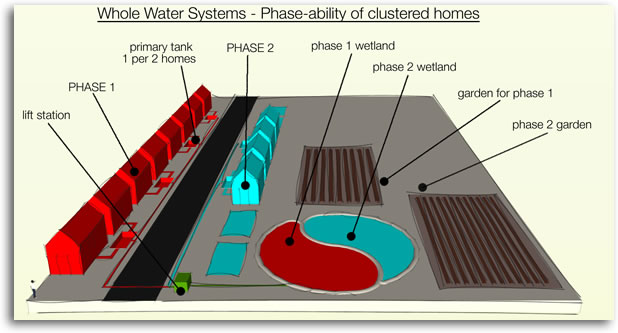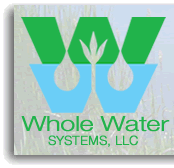Sustainable Water Treatment for Developments
Subdivisions, Master Planned Communities, Urban Infill
Benefits to Developers
- Affordable, tertiary treatment to reuse standards
- Scales well – single family / clusters / campus / municipal
- Phases well – build as-you-go, lower up front infrastructure cost
- Landscape amenity – attractive, silent, odor-free
- Little to no energy use
-
Minimal maintenance and license / certification requirements  Biological filtration
Biological filtration – harnessing nature to purify and reuse a precious resource
CWB - Constructed Wetland Bioreactor
– tertiary treatment with attractive landscape amenities
RGB - Advanced Recirculating Gravel Biofiltration
– high-performance biofiltration, maximum water reuse
VSB - Vertical Shaft Bioreactor
– high-flow solutions that use less land and energy, and make good neighbors
Wastewater – Historically Tough Choice: Septic or Sewer
Developments have had limited and often expensive choices with respect to wastewater: pay for the connection to the municipal sewer system or accept the low density requirements of conventional septic systems. With best development practices focusing on green and sustainability, sewer hookups and septic disposal fields that treat water as “waste” and assume there is an “away” are increasingly being called into question. Sustainable projects are taking their cue from green standards like LEED and the Living Building Challenge which encourage or even mandate that projects treat and reuse their water on site. Some of the “green” solutions for the developer’s wastewater dilemma come at a high cost in terms of price tag, flexibility, maintenance and even the environment.
MBR = Expensive, Inflexible, High-maintenance, Energy Intensive
A conventional engineering approach is to recommend that projects replicated municipal systems by installing a centralized treatment plant and sewer lines to all the buildings. If the sewage plant utilizes the latest Membrane Bioreactor (MBR) technology, then the system is considered green because water is treated to high tertiary standards and suitable for reuse. The problem for developers is that these centralized solutions come with a hefty upfront price tag – first for the sewage plant and then for the sewer pipes (EPA estimates that collection systems typically account for 70% of the overall cost of centralized wastewater systems). Since the system needs to be functioning before the first home can be occupied the developer typically incurs the cost of the entire system before lots can be sold. That can be a significant financial risk and one that forces a developers hand and reduces their flexibility with respect to phasing a project. Once a sewer plant and collection system are in place, there is also the issue of operation and maintenance (O&M) – something developers familiar with septic systems and sewer hookups haven’t had to deal with. MBRs can be sophisticated and sensitive beasts that require hand holding by highly trained technicians. Owners managing O&M for MBR systems report that even if a full time engineer wasn’t foreseen, one is often required.
How Green is “Green”?
Centralized wastewater treatment with an MBR plant may treat water to reuse standards, but there can be significant tradeoffs with respect to the overall sustainable picture. Projects utilizing integrated design may question some of the following liabilities
- MBR technology’s tremendous energy requirements
- MBR technology’s relatively short effective life and high part replacement requirements
- environmental impact of centralized sewer pipe installation and tendency to dewater the surroundings (“French drain” effect)
Good Solutions: Decentralized, Biofiltration
The good news for developers is that the truly sustainable solution – treating and reusing the water as close as possible to its source and point of use – brings with it significant benefits to a project.
Affordable, tertiary treatment to reuse standards
A truly decentralized approach removes the need for extensive collection. Since the sewer pipes represent the majority of the cost of the system, the savings can be significant. The EPA recognizes constructed wetlands as providing tertiary treatment to reuse standards so the more attractive solution can also provide high performance.
Scales well – single family / clusters / campus / municipal
Decentralized treatment can be tailored to the job at hand whether it’s for a single family residence, a cluster of buildings or a high-flow municipal scale application. This flexibility can provide tremendous advantages to land use planners and designers. By decoupling the need to facilitate sewer connections, designers and land planners have more choices with lot and building design.
Phases well – build as-you-go, lower up front infrastructure cost
Developers can hedge their financial risk by only building the wastewater and stormwater infrastructure they need – as they need it. With a decentralized approach, if only Phase 1 of a project has been built and is being sold, then only that phase’s water treatment costs have been incurred. And there isn’t any need to feed dog food to a large finicky central treatment plant that needs more occupants before it can function properly.
Landscape amenity – attractive, silent, odor-free
With good design, constructed wetlands can be an attractive asset to the landscaping. Because the water level is kept below the surface, the ground always remains dry and there is no odor and no possibility of breeding mosquitoes. Constructed wetlands can be designed with lush showy plants that invite gardening or with wetland grasses that can be mowed like surrounding turf. Because it is the plants that bring oxygen to the bacteria performing treatment under the surface, there is no need for a noisy blower to pump oxygen.
Little to no energy use
If topology allows, gravity can be used and no energy needs to be consumed for a constructed wetland to treat wastewater to tertiary standards and then to make beneficial reuse through a subsurface drip irrigation system. If the ground is flat, then a lift station is placed between the septic tank and the constructed wetland with a low energy sump pump that only operates long enough to move the intermittent flows.
Minimal maintenance and license / certification requirements
Similar to conventional septic systems, the primary maintenance of decentralized systems consists of monitoring the septic tanks and making sure that they are pumped on a regular basis. This can be easily managed by an HOA by setting up a maintenance contract with locally available pumping services. Unlike more complicated mechanical systems, constructed wetlands qualify for the EPA’s most basic level of operator certification – again, significantly reducing O&M costs.
 |


